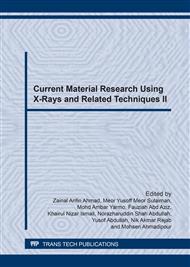[1]
N.J. Sangeetha, A.M. Retna, Y.J. Joy, A. Sophia, A review on advanced methods of polyurethane synthesis based on natural resources, Journal of Chemical and Pharmaceutical Sciences, 7(3) (2014) 242-249.
Google Scholar
[2]
P. Li, Y. Tao, Q.S. Sheldon, Modal analysis of upright piano sound board by combining finite element analysis and computer aided design. Journal of BioResources, 46(3) (2014) 376-384.
Google Scholar
[3]
H. Pawlik, A. Prociak, Influence of palm oil-based polyol on the properties of flexible polyurethane foams, Journal of Polymers and Environment, 20 (2) (2012) 435-445.
DOI: 10.1007/s10924-011-0393-2
Google Scholar
[4]
M.Z. Arniza. S.S. Hoong, Z. Idris, S.K. Yeong, H.A. Hassan, A.K. Din, Y.M. Choo, Synthesis of transesterified palm olein-based polyol and rigid polyurethanes from this polyol, J. Am. Oil Chem. Soc. 92(2) (2015) 243-255.
DOI: 10.1007/s11746-015-2592-9
Google Scholar
[5]
N.F. Zaaba, H. Ismail, M. Jaafar, The effects of modifying peanut shell powder with polyvinyl alcohol on the properties of recycled polypropylene and peanut shell powder composites, Journal of BioResources, 9(2) (2014) 2128-2142.
DOI: 10.15376/biores.9.2.2128-2142
Google Scholar
[6]
M.R. Ishak, Z. Leman, S.M. Sapuan, A.M.M. Edeerozey, I.S. Othman, Mechanical properties of kenaf bast and core fibre reinforced unsaturated polyester composites, Journal of Materials Science and Engineering, 11 (2009) 012006.
DOI: 10.1088/1757-899x/11/1/012006
Google Scholar
[7]
A.M.M. Edeerozey, H.M. Akil, A.B. Azhar, M.I.Z. Ariffin, Chemical modification of kenaf fibers, Journal of Materials Letters, 61(10) (2007) 2023-(2025).
DOI: 10.1016/j.matlet.2006.08.006
Google Scholar
[8]
H.P.S.A. Khalil, N.L. Suraya, Anhydride modification of cultivated kenaf bast fibers: morphological, spectroscopic and thermal studies, Journal of BioResources, 6(2) (2011) 1122-1135.
DOI: 10.15376/biores.6.2.1122-1135
Google Scholar
[9]
C.L. Webber III, V.K. Bledsoe, R.E. Bledsoe, Kenaf harvesting and processing, reprinted from: trends in new crops and new uses. 2002. J. Janick and A. Whipkey (eds. ). ASHS Press, Alexandria, VA.
Google Scholar
[10]
X. Pan, J.N. Sadler, Effect of replacing polyol by organosolv and kraft lignin on the property and structure of rigid polyurethane foam, Journal of Biotechnology for Biofuels, 12 (2013) 1-10.
DOI: 10.1186/1754-6834-6-12
Google Scholar
[11]
M.A.N. Azni, A.A. Sinar, Z. Firuz, A.G. Supri, Characterization and mechanical properties of biomass polyurethane, Journal of Advances in Environmental Biology, 7(12) (2013) 3696-3699.
Google Scholar


